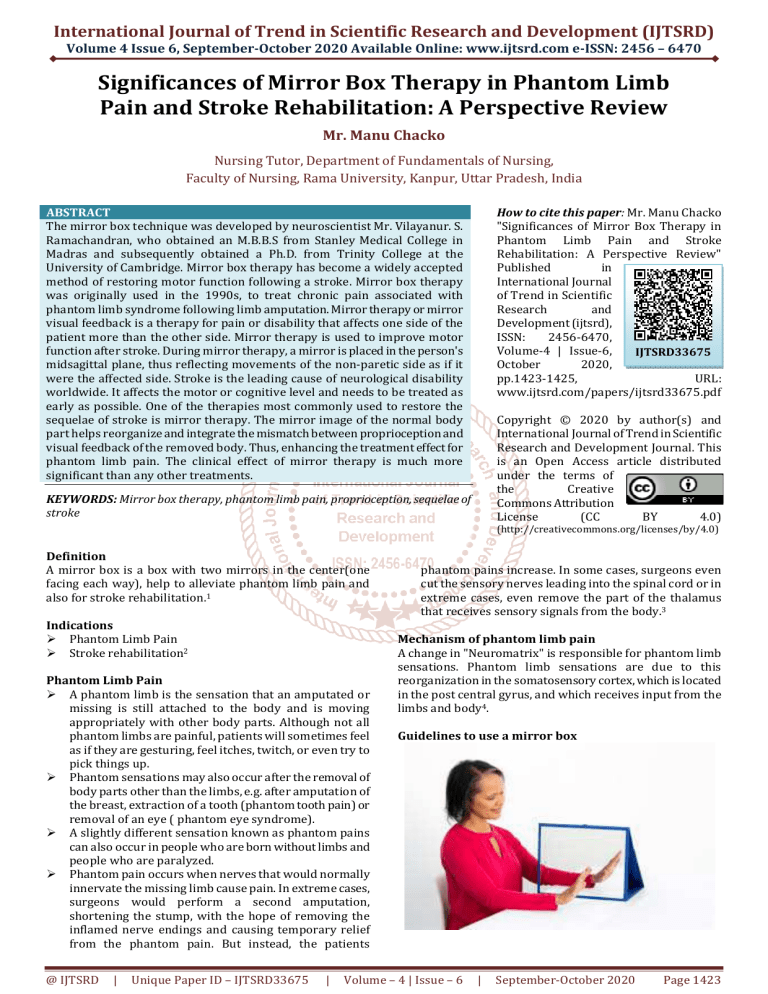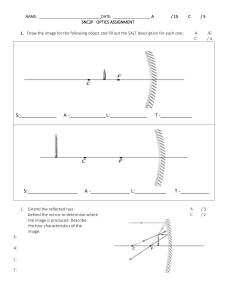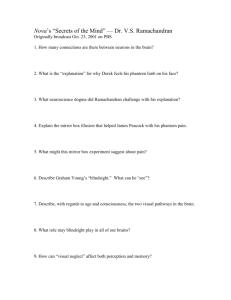
International Journal of Trend in Scientific Research and Development (IJTSRD)
Volume 4 Issue 6, September-October 2020 Available Online: www.ijtsrd.com e-ISSN: 2456 – 6470
Significances of Mirror Box Therapy in Phantom Limb
Pain and Stroke Rehabilitation: A Perspective Review
Mr. Manu Chacko
Nursing Tutor, Department of Fundamentals of Nursing,
Faculty of Nursing, Rama University, Kanpur, Uttar Pradesh, India
ABSTRACT
The mirror box technique was developed by neuroscientist Mr. Vilayanur. S.
Ramachandran, who obtained an M.B.B.S from Stanley Medical College in
Madras and subsequently obtained a Ph.D. from Trinity College at the
University of Cambridge. Mirror box therapy has become a widely accepted
method of restoring motor function following a stroke. Mirror box therapy
was originally used in the 1990s, to treat chronic pain associated with
phantom limb syndrome following limb amputation. Mirror therapy or mirror
visual feedback is a therapy for pain or disability that affects one side of the
patient more than the other side. Mirror therapy is used to improve motor
function after stroke. During mirror therapy, a mirror is placed in the person's
midsagittal plane, thus reflecting movements of the non-paretic side as if it
were the affected side. Stroke is the leading cause of neurological disability
worldwide. It affects the motor or cognitive level and needs to be treated as
early as possible. One of the therapies most commonly used to restore the
sequelae of stroke is mirror therapy. The mirror image of the normal body
part helps reorganize and integrate the mismatch between proprioception and
visual feedback of the removed body. Thus, enhancing the treatment effect for
phantom limb pain. The clinical effect of mirror therapy is much more
significant than any other treatments.
How to cite this paper: Mr. Manu Chacko
"Significances of Mirror Box Therapy in
Phantom Limb Pain and Stroke
Rehabilitation: A Perspective Review"
Published
in
International Journal
of Trend in Scientific
Research
and
Development (ijtsrd),
ISSN:
2456-6470,
Volume-4 | Issue-6,
IJTSRD33675
October
2020,
pp.1423-1425,
URL:
www.ijtsrd.com/papers/ijtsrd33675.pdf
Copyright © 2020 by author(s) and
International Journal of Trend in Scientific
Research and Development Journal. This
is an Open Access article distributed
under the terms of
the
Creative
Commons Attribution
License
(CC
BY
4.0)
KEYWORDS: Mirror box therapy, phantom limb pain, proprioception, sequelae of
stroke
(http://creativecommons.org/licenses/by/4.0)
Definition
A mirror box is a box with two mirrors in the center(one
facing each way), help to alleviate phantom limb pain and
also for stroke rehabilitation.1
Indications
Phantom Limb Pain
Stroke rehabilitation2
Phantom Limb Pain
A phantom limb is the sensation that an amputated or
missing is still attached to the body and is moving
appropriately with other body parts. Although not all
phantom limbs are painful, patients will sometimes feel
as if they are gesturing, feel itches, twitch, or even try to
pick things up.
Phantom sensations may also occur after the removal of
body parts other than the limbs, e.g. after amputation of
the breast, extraction of a tooth (phantom tooth pain) or
removal of an eye ( phantom eye syndrome).
A slightly different sensation known as phantom pains
can also occur in people who are born without limbs and
people who are paralyzed.
Phantom pain occurs when nerves that would normally
innervate the missing limb cause pain. In extreme cases,
surgeons would perform a second amputation,
shortening the stump, with the hope of removing the
inflamed nerve endings and causing temporary relief
from the phantom pain. But instead, the patients
@ IJTSRD
|
Unique Paper ID – IJTSRD33675
|
phantom pains increase. In some cases, surgeons even
cut the sensory nerves leading into the spinal cord or in
extreme cases, even remove the part of the thalamus
that receives sensory signals from the body.3
Mechanism of phantom limb pain
A change in "Neuromatrix" is responsible for phantom limb
sensations. Phantom limb sensations are due to this
reorganization in the somatosensory cortex, which is located
in the post central gyrus, and which receives input from the
limbs and body4.
Guidelines to use a mirror box
Volume – 4 | Issue – 6
|
September-October 2020
Page 1423
International Journal of Trend in Scientific Research and Development (IJTSRD) @ www.ijtsrd.com eISSN: 2456-6470
Mirror box in which a mirror is placed vertically in front
of the patient and has patients look at the mirror
reflection of the normal arm so that the reflection is
optically superimposed on the felt location of the
phantom thus creating the visual illusion that the
phantom has been resurrected.
Stroke rehabilitation
Presuming there is no jewellery on the affected side,
remove any wrist watches and rings from your
unaffected side. If you have any tattoos or scarring, try
to cover this up to make a total illusion.
The patient puts his intact hand in one side, of a box and
"inserts" his phantom hand in the other side
Once the patient places the intact hand into one
compartment of the box the mirror produces a "stereo
isomeric image" of the other hand.4
The patient observes in the mirror the image of his real
hand, and then asks to make similar movements with
both "hands", which suggests to the brain real
movement from the lost hand.
Depending on the pain and disability state, decide on an
appropriate activity to perform with the good hand. This
could range from just looking at the mirror image to
finger movements, or taking weight through the hand.
Feel comfortable with your selected movements'conquer the movement' before progressing to a more
challenging movement. Once u feel comfortable with a
movement, try and perform it in a different context.5
Overall, you will need to repeat movements, grade the
movements from easy to more difficult and then enrich
the movement with different contexts for best neuron
health.
Take care. If the hand in the box hurts or sweats, you
may have taken the brain exercises too far even though
the hand has not been harmed. Don't worry though, just
take a break and try something a little less challenging
next time.
Move the painful hand in the box to the point where it
starts to hurt a little( e.g. a loose fist) and then move the
good hand which is outside the box a little bit further(
e.g. a tight fist).6
By placing a mirror between the feet, a similar therapy
can be performed for the foot.10
When taking stroke rehabilitation exercises the use of a
mirror has been proven to be a great asset. Increased
disinhibition of the motor cortex allowing increased use
of spared pathways within the damaged hemisphere,
increased activity of motor command pathways in the
affected hemisphere running to the spinal nerves and
increased activation of the pathways from the
unaffected hemisphere to supplement the damaged
crossed corticospinal pathways. The term plasticity
describes the ability of the brain to rewire itself and
there is no better way to help this than the use of a
mirror.8
Visualizing and undertaking symmetrical bilateral
movements post stroke enhance neuroplastic
(Adaptation of nervous system to the stimuli) changes
within the brain.
Mirror therapy has been described in medical literature
to be of benefit to 80% of users, but all therapies do not
always show immediate results.
The rate and amount of recovery much depends on the
extent of the damage, and the intensity and duration of
the therapy the patient receives. Recovery also is likely
to be influenced by personality, life experiences and
coping styles. Motivation to recover is a key factor in
obtaining an optimal level of rehabilitation.
The role of mirror box/visual therapy in this bilateral
movement training is central to its success9.
The phantom pain is the consequence of a mismatch
between the brain's creation of a phantom limb and the
visual realization that the limb does not exist.
Conclusion
Pain relief associated with mirror therapy may be due to the
activation of mirror neurons in the hemisphere of the brain
that is contra lateral to the amputated limb. These neurons
fire when a person either performs an action or observes
another person performing an action. Alternatively, visual
input of what appears to be movement of the amputated
limb might reduce the activity of systems that perceive
protopathic pain. Although the underlying mechanism
accounting for the success of this therapy remains to be
elucidated, these results suggests that mirror therapy may
be helpful in alleviating phantom pain in an amputated lower
limb.11
Moving the intact limb creates the illusion that the
phantom limb is moving, and over time this illusion
reduces the pain experienced by the patient. Several
research studies using mirror therapy have produced
promising results7.
References
[1] Ramachandran, VS., Rogers Ramachandran, DC, Cobb,
S. (1995), "Touching the phantom", Nature (377):489490.
Implications of the experiment
The body self neuromatrix constantly expects sensory
inputs from all part of the body to generate the
awareness of the "self"
When these inputs are missing from any part due to any
cause the Matrix generates the input using pain the most
"acute" of all sensations to create an illusion that the
limb still exists10
@ IJTSRD
|
Unique Paper ID – IJTSRD33675
|
Volume – 4 | Issue – 6
|
September-October 2020
Page 1424
International Journal of Trend in Scientific Research and Development (IJTSRD) @ www.ijtsrd.com eISSN: 2456-6470
[2]
Ramachandran, VS. Blakeslee, S. (1998), Phantoms in
the brain: Probing the mysteries of the human mind,
William Morrow & Company, ISBN 0-688-15247-3
[3]
Michielsen et al (2010), "The Neuronal correlates of
mirror therapy: an FMRI study on mirror induced
visual illusions in stroke patients", Journal of
Neurology, Neurosurgery and Psychiatry.4 (82): 393
[4]
Brenda L. Chan, B. A. Mirror Therapy for Phantom
Limb Pain. New England Journal of Medicine 2007;
357:2206-2207.
[5]
Rossi S, Tecchio F, Pasqualetti P, et al. Somatosensory
processing during movement observation in humans.
Clinical Neurophysiology. 2002; 113:16-20.
[6]
Henson RA. Henry Head: his influence on the
development of ideas on sensation. British Medical
Bulletin. 1977; 33:91-96
@ IJTSRD
|
Unique Paper ID – IJTSRD33675
|
[7]
Clinical Trials of Mirror Box Therapy. Recent CBC
News updates and thoughts from members of the
center for brain and cognition. Retrieved from
http://centerforbrainand
cognition.blogspot.in/2012/06/clinical-trials-ofmirror-box-therapy.html. Tuesday, June12,2012
[8]
http://www. mirrorboxtherapy.com/
[9]
http://en.wikepedia.org/wiki/Mirror_box.
[10]
http://www.themanualtherapist.com/p/mirror-boxtx.html.
[11]
http://www.gradedmotorimagery.com/mirrortherap
y.htm
Volume – 4 | Issue – 6
|
September-October 2020
Page 1425




